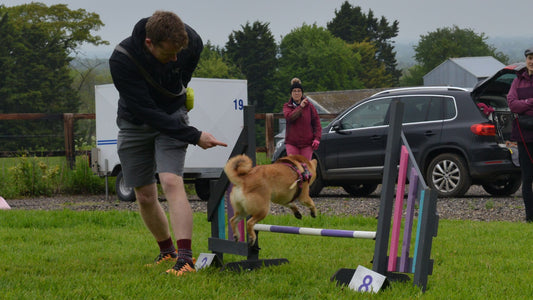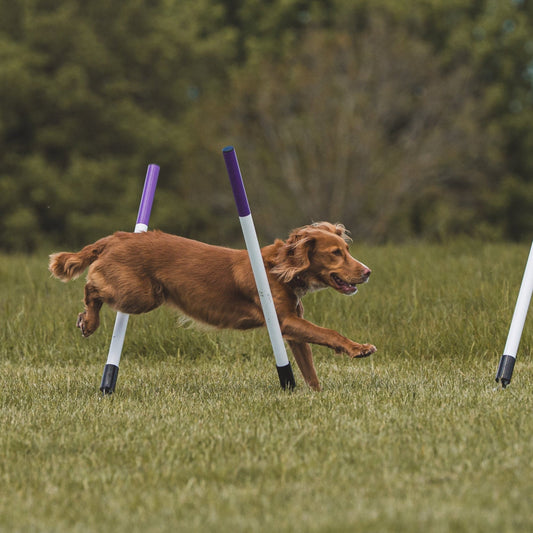Blind Cross in Dog Agility
What is a blind cross?
It’s called blind because you will get ahead on a course, so your dog will be behind and you take your eyes off them as you change the handling side.

Why use a blind cross
Because a blind cross allows efficient forward motion, it can be useful if you need to get ahead on the course.
You don't need any collection from the dog or yourself, which allows for acceleration.
Note: only works on angle changes less than 45 degrees.
How to do a blind cross?
So, these would be the steps that you as a handler goes through when doing a blind cross.
And please don’t worry if it sounds a bit complicated, I will give a full explanation in class and will train it in progressive, achievable phases (steps 1, 2 & 3 below)
- You will face forward the whole time, in the direction of travel.
- Staying close to where you intend your dog to run means you don't pull them off course.
- Dogs get so much information from watching your body language, so look to where you want them to go and hold out your arm to guide them until they commit to the obstacle.
- When they commit and before they’ve landed, turn to look at the side you want them to come after the obstacle and then your guiding arm changes as the handling side changes.
Step 1: Blind cross on a recall
- Approach a Place Board with your dog on your right
- Say “Place” to cue them to sit and stay on the platform as you walk out to 10 paces
- Stand with your back to your dog
- Look back over your right shoulder with your right arm outstretched.
- Recall them.
- When your dog is halfway to you, switch to looking over your left shoulder and hold your left arm out and notice how this changes the line your dog runs.
Repeat the steps above, but agtet recalling your dog, take a couple of steps forward before you perform the cross.
Want a challenge? Increase distance between you and your dog; move faster.
Step 2: Blind cross over 1 jump
- Have a Place Board 5-10 paces from a jump.
- Say “Place” to cue them to sit and stay on the platform as you walk out to the left wing.
- Hold out your arm closest to your dog (right).
- Release your dog over the jump and start walking left to right in front of them.
- As they take the jump, swap to guide with your left arm so that they land and have crossed to be on the other side of you.
Want a challenge? You can make it harder by changing the distance or approach angles of the obstacle

Step 3: we’ll try it out on a course.

TIPS: position yourself just one step away from where your dog will be travelling to show them what line that they will take after the cross.
You can call your dog’s name to get their attention if needed.
Make sure they've committed before you change your arms so that they don't get pulled off of the jump that you want them to take.
Like the content we put out and want to stay updated and in the know?

Join our subscribers to gain short weekly emails (under 1-minute reads) plus the opportunity to reach out & get professional advice on your own training challenges. Read answers to members' FAQs, receive training & equipment news offers and tips directly to your inbox.
Click here to join our subscribers
About the author: Hi 👋 I’m Emma, accredited as a professional dog trainer by the Institute of Modern Dog Trainers (IMDT). I help owners of energetic dogs achieve the dog-owning life they envisioned by providing robust obedience & agility training for dogs across my two venues in Balsham and Barton, near Cambridge.
Disclaimer: The content of this article does not include personalised advice and is for information purposes only. If you need individual advice or other enquiries please click here to get in contact or if you're not local to Anglian Dog Works, you can find a trainer in your area by going to the IMDT website: https://www.imdt.uk.com/find-a-qualified-imdt-trainer


